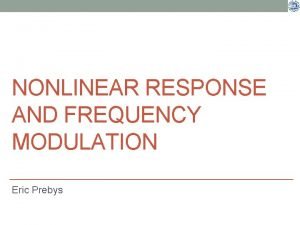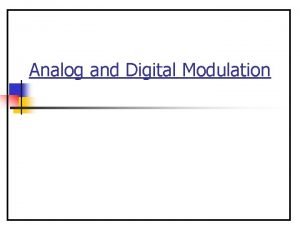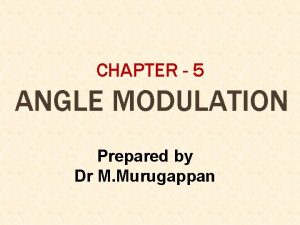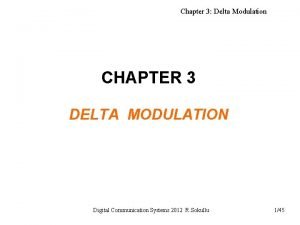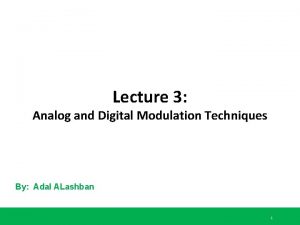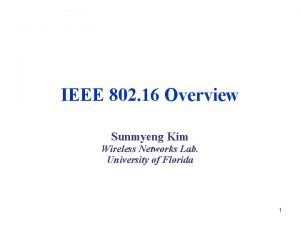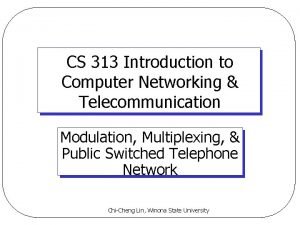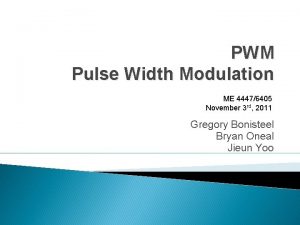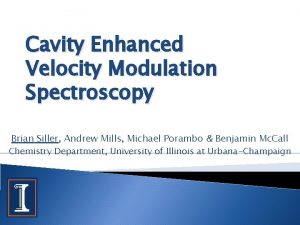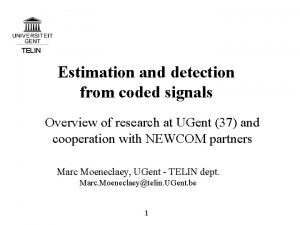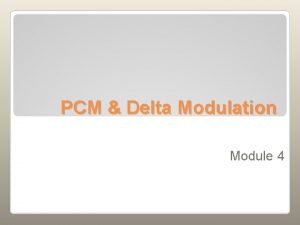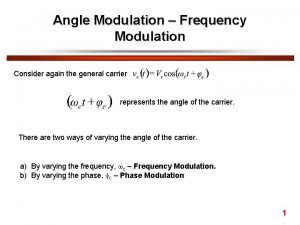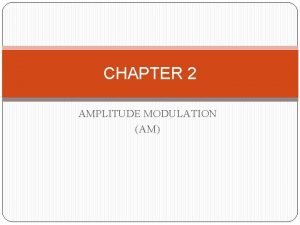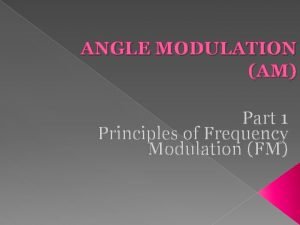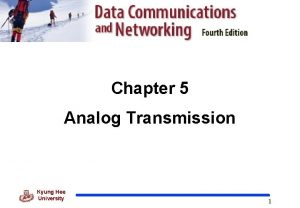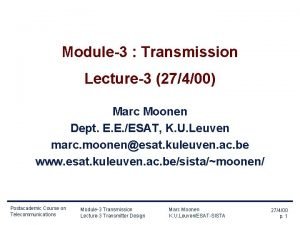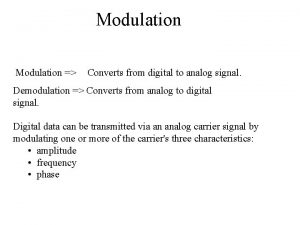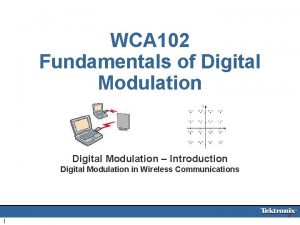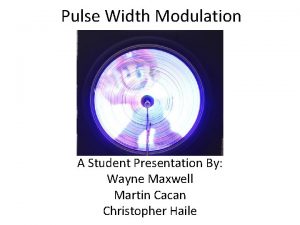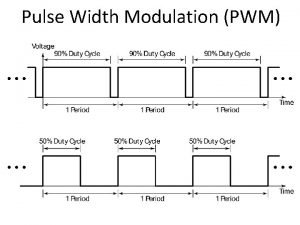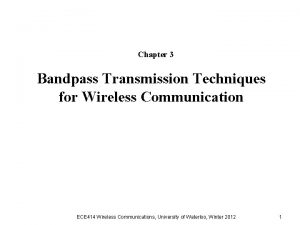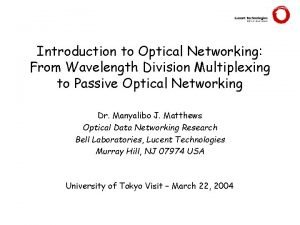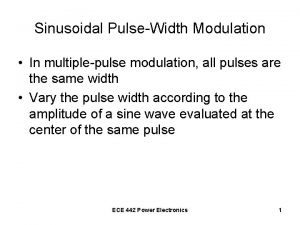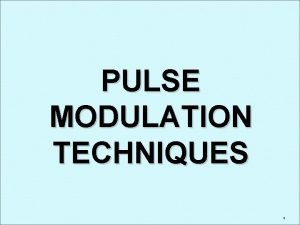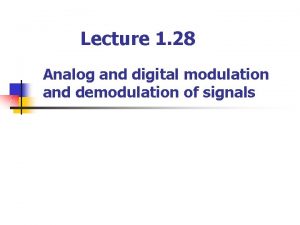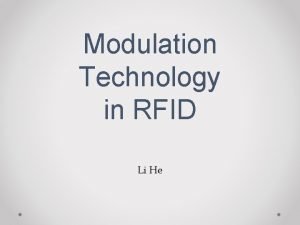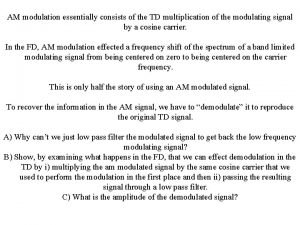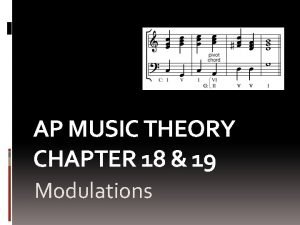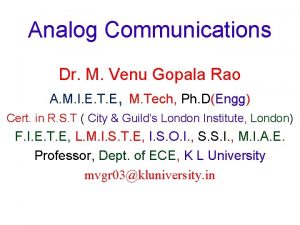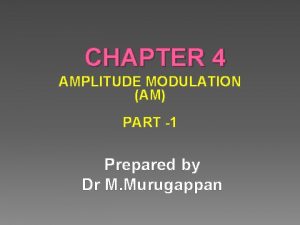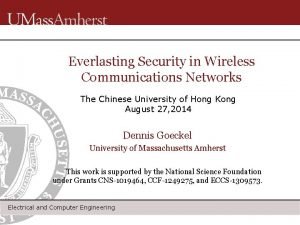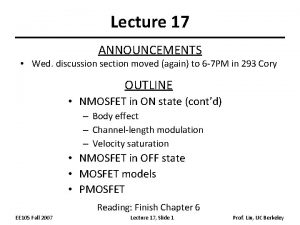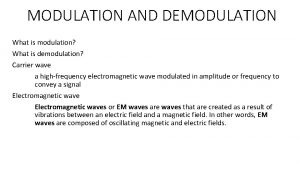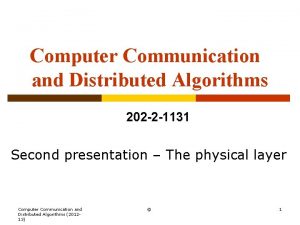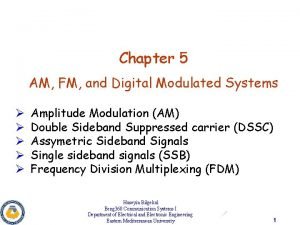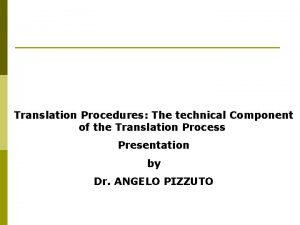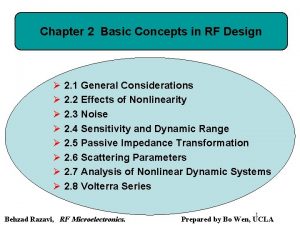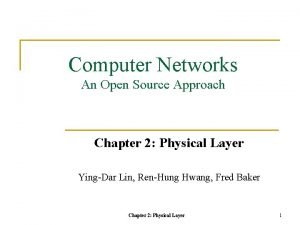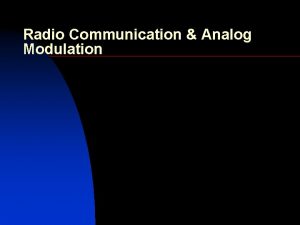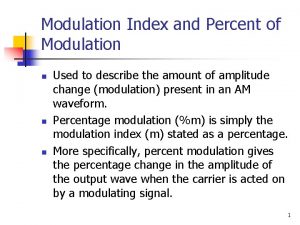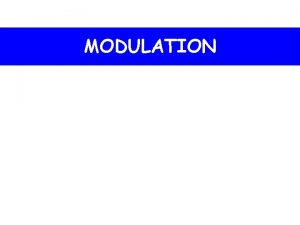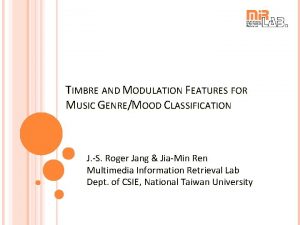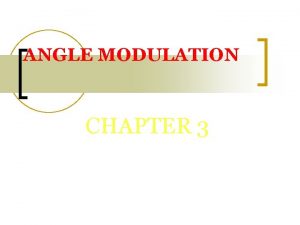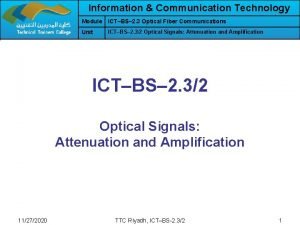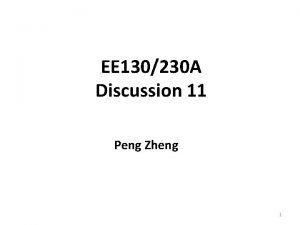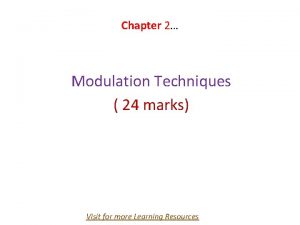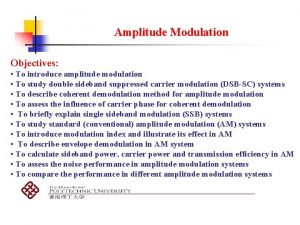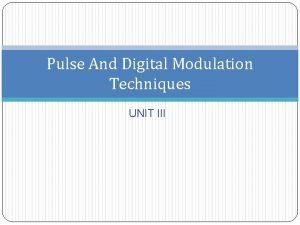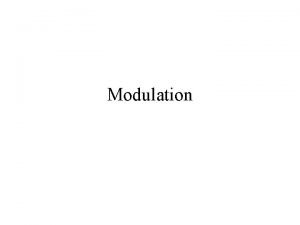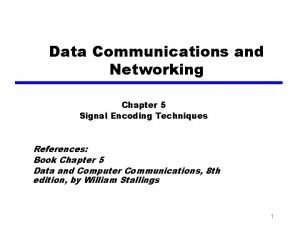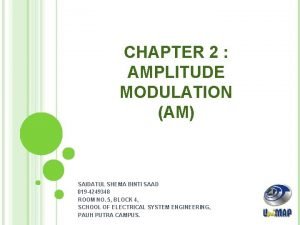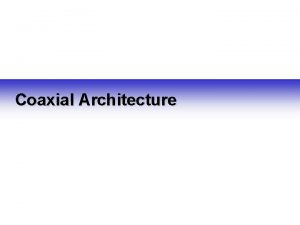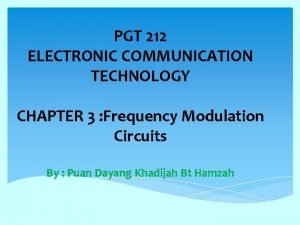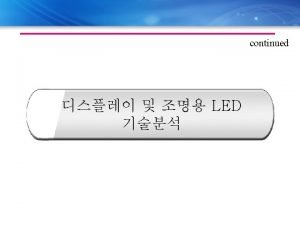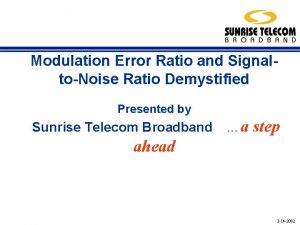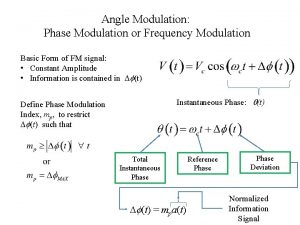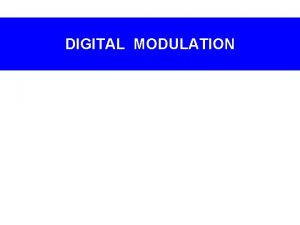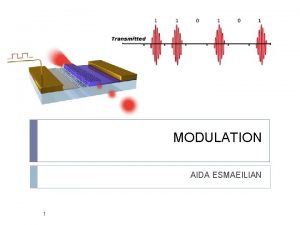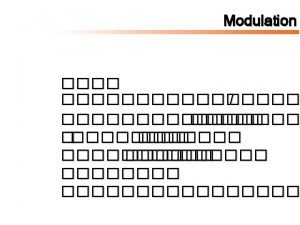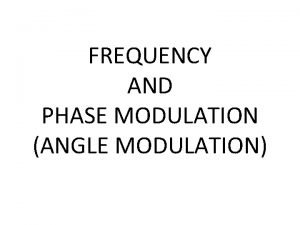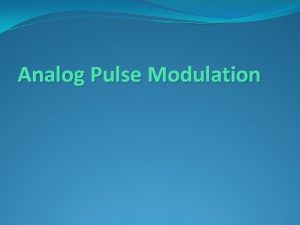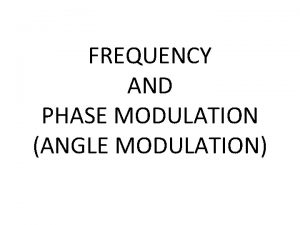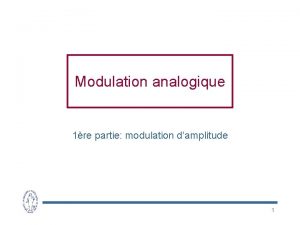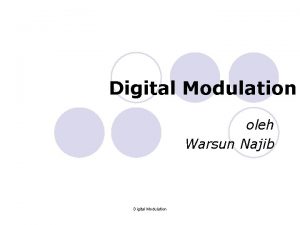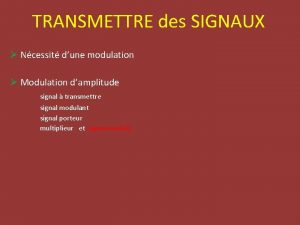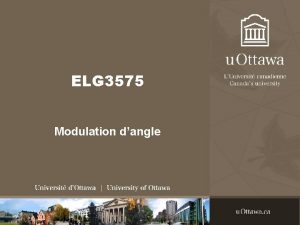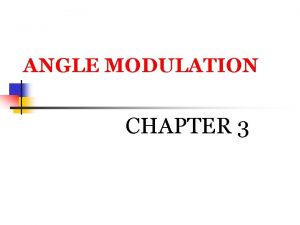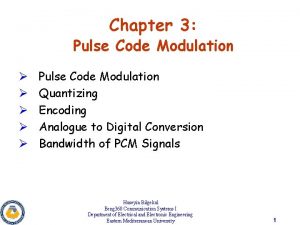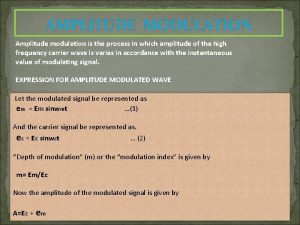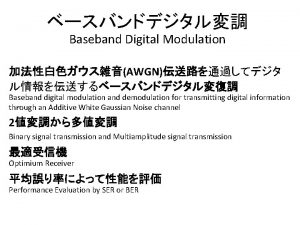MODULATION 1 What is modulation 1 What is








































































- Slides: 72

MODULATION

1. What is modulation?

1. What is modulation? • Modulation is the process of putting information onto a high frequency carrier for transmission (frequency translation).

• Once this information is received, the low frequency information must be removed from the high frequency carrier. This process is known as “ Demodulation”.


2. What are the reasons for modulation?

2. What are the reasons for modulation? 1. Frequency division multiplexing (To support multiple transmissions via a single channel) To avoid interference

M 1(f) Multiplexed signal M(f) f 0 + M 2(f) 0 f 1 f 2 f

2. Practicality of Antennas Transmitting very low frequencies require antennas with miles in wavelength

3. What are the Different of Modulation Methods?

3. What are the Different of Modulation Methods? 1. Analogue modulation- The modulating signal and carrier both are analogue signals Examples: Amplitude Modulation (AM) , Frequency Modulation (FM) , Phase Modulation (PM) 2. Pulse modulation- The modulating signal is an analogue signal but Carrier is a train of pulses Examples : Pulse amplitude modulation (PAM), Pulse width modulation (PWM), Pulse position modulation (PPM)

3. What are the Different of Modulation Methods? 3. Digital to Analogue modulation- The modulating signal is a digital signal , but the carrier is an analogue signal. Examples: Amplitude Shift Keying (ASK), FSK, Phase Shift Keying (PSK) 4. Digital modulation Examples: Pulse Code Modulation, Delta Modulation, Adaptive Delta Modulation

ANALOG AND DIGITAL Analog-to-analog conversion is the representation of analog information by an analog signal. One may ask why we need to modulate an analog signal; it is already analog. Modulation is needed if the medium is bandpass in nature or if only a bandpass channel is available to us. Topics discussed in this section: Amplitude Modulation Frequency Modulation Phase Modulation

Figure Types of analog-to-analog modulation

Figure Amplitude modulation

Note The total bandwidth required for AM can be determined from the bandwidth of the audio signal: BAM = 2 B.

Figure AM band allocation

Note The total bandwidth required for FM can be determined from the bandwidth of the audio signal: BFM = 2(1 + β)B.

Figure Frequency modulation

Figure FM band allocation

Figure Phase modulation

Note The total bandwidth required for PM can be determined from the bandwidth and maximum amplitude of the modulating signal: BPM = 2(1 + β)B.

4. What are the Basic Types of Analogue Modulation Methods ?

4. What are the Basic Types of Analogue Modulation Methods ? Consider the carrier signal below: sc(t ) = Ac(t) cos( 2 fc t + ) 1. Changing of the carrier amplitude Ac(t) produces Amplitude Modulation signal (AM) 2. Changing of the carrier frequency fc produces Frequency Modulation signal (FM) 3. Changing of the carrier phase produces Phase Modulation signal (PM)

Analogue Modulation Methods


5. What are the different Forms of Amplitude Modulation ?

5. What are the different Forms of Amplitude Modulation ? 1. Conventional Amplitude Modulation (DSB-LC) (Alternatively known as Full AM or Double Sideband with Large carrier (DSB-LC) modulation 2. Double Side Band Suppressed Carrier (DSB-SC) modulation 3. Single Sideband (SSB) modulation 4. Vestigial Sideband (VSB) modulation

Conventional Amplitude Modulation (Full AM)

6. Derive the Frequency Spectrum for Full-AM Modulation (DSB-LC)

6. Derive the Frequency Spectrum for Full-AM Modulation (DSB-LC) 1 The carrier signal is 2 In the same way, a modulating signal (information signal) can also be expressed as

3 The amplitude-modulated wave can be expressed as 4 By substitution 5 The modulation index.

6 Therefore The full AM signal may be written as

7. Draw the Frequency Spectrum of the above AM signal and calculate the Bandwidth

7. Draw the Frequency Spectrum of the above AM signal and calculate the Bandwidth fc-fm f. C 2 fm fc+fm

8. Draw Frequency Spectrum for a complex input signal with AM

8. Draw Frequency Spectrum for a complex input signal with AM fc-fm fc fc+fm

Frequency Spectrum of an AM signal The frequency spectrum of AM waveform contains three parts: 1. A component at the carrier frequency fc 2. An upper side band (USB), whose highest frequency component is at fc+fm 3. A lower side band (LSB), whose highest frequency component is at fc-fm The bandwidth of the modulated waveform is twice the information signal bandwidth.

• Because of the two side bands in the frequency spectrum its often called Double Sideband with Large Carrier. (DSBLC) • The information in the base band (information) signal is duplicated in the LSB and USB and the carrier conveys no information.

Example We have an audio signal with a bandwidth of 5 KHz. What is the bandwidth needed if we modulate the signal using AM?

Example We have an audio signal with a bandwidth of 5 KHz. What is the bandwidth needed if we modulate the signal using AM? Solution An AM signal requires twice the bandwidth of the original signal: BW = 2 x 5 KHz = 10 KHz

AM Radio Band

(m) 9. Modulation What is the. Index significance of modulation index ? • m is merely defined as a parameter, which determines the amount of modulation. • What is the degree of modulation required to establish a desirable AM communication link? Answer is to maintain m<1. 0 (m<100%). • This is important for successful retrieval of the original transmitted information at the receiver end.

(m) 9. Modulation What is the. Index significance of modulation index ?


• If the amplitude of the modulating signal is higher than the carrier amplitude, which in turn implies the modulation index . This will cause severe distortion to the modulated signal.

Power distribution in full AM 10. Calculate the power efficiency of AM signals

10. Calculate the power efficiency of AM signals • The ratio of useful power, power efficiency : • In terms of power efficiency, for m=1 modulation, only 33% power efficiency is achieved which tells us that only one-third of the transmitted power carries the useful information.

Double Side Band Suppressed Carrier (DSB-SC) Modulation • The carrier component in full AM or DSB-LC does not convey any information. Hence it may be removed or suppressed during the modulation process to attain higher power efficiency. • The trade off of achieving a higher power efficiency using DSB-SC is at the expense of requiring a complex and expensive receiver due to the absence of carrier in order to maintain transmitter/receiver synchronization.

11. Derive the Frequency Spectrum for Double Sideband Suppressed Carrier Modulation (DSB-SC) 1 Consider the carrier 2 modulated by a single sinusoidal signal 3 The modulated signal is simply the product of these two

X Frequency Spectrum of a DSB-SC AM Signal fc-fm fc fc+fm

• All the transmitted power is contained in the two sidebands (no carrier present). • The bandwidth is twice the modulating signal bandwidth. • USB displays the positive components of sm(t) and LSB displays the negative components of sm(t).

Generation and Detection of DSB-SC • The simplest method of generating a DSB-SC signal is merely to filter out the carrier portion of a full AM (or DSB -LC) waveform. • Given carrier reference, modulation and demodulation (detection) can be implemented using product devices or balanced modulators.

BALANCED MODULATOR Sm(t) AM Modulator 1 S 1(t) Accos(wct) Sm(t) Carrier DSB-SC Accos(wct) AM Modulator 2 -Sm(t) S 2(t)

• The two modulators are identical except for the sign reversal of the input to one of them. Thus,

COHERENT (SYNCHRONOUS) DETECTOR OR DSB-SC (PRODUCT DETECTOR) v(t) DSB-SC Signal s(t) X LPF vo(t) Coswct Local Oscillator • Since the carrier is suppressed the envelope no longer represents the modulating signal and hence envelope detector which is of the non-coherent type cannot be used.


• It is necessary to have synchronization in both frequency and phase between the transmitter (modulator) & receiver (demodulator), when DSB-SC modulation , which is of the coherent type, is used. Both phase and frequency must be known to demodulate DSB-SC waveforms.

LACK OF PHASE SYNCHRONISATION Let the received DSB-SC signal be if is unknown, Output of LPF

But we want just Due to lack of phase synchronization, we will see that the wanted signal at the output of LPF will be attenuated by an amount of cos. In other words, phase error causes an attenuation of the output signal proportional to the cosine of the phase error. The worst scenario is when = /2, which will give rise to zero or no output at the output of the LPF.

LACK OF FREQUENCY SYNCHRONISATION Suppose that the local oscillator is not stable at fc but at fc+D f, then Output of LPF Thus, the recovered baseband information signal will vary sinusoidal according to cos D wt

This problem can be overcome by adding an extra synchronization circuitry which is required to detect and D wt and by providing the carrier signal to the receiver. A synchronizer is introduced to curb the synchronization problem exhibited in a coherent system. Let the baseband signal be Received DSB-SC signal

SYNCHRONISER ( )2 PLL BPF 2 Mathematical analysis of the synchronizer is shown below: Output of BPF

Output of frequency divider where k is a constant of proportionality. DISADVANTAGE OF USING COHERENT SYSTEMS • The frequency and phase of the local oscillator signal must be very precise which is very difficult to achieve. It requires additional circuitry such as synchronizer circuit and hence the cost is higher.

Single-Sideband Modulation Single Side Band Modulation (SSB) How to generate SSB signal? • Generate DSB-SC signal • Band-pass filter to pass only one of the sideband suppress the other. For the generation of an SSB modulated signal to be possible, the message spectrum must have an energy gap centered at the origin.

• Example of signal with -300 Hz ~ 300 Hz energy gap Voice : A band of 300 to 3100 Hz gives good articulation • Also required for SSB modulation is a highly selective filter

• Vestigial Sideband Modulation Vestigial Side Band Modulation (VSB) Instead of transmitting only one sideband as SSB, VSB modulation transmits a partially suppressed sideband a vestige of the other sideband.

Comparison of Amplitude Modulation methods

Comparison of Amplitude Modulation methods - Full AM (or DSB-LC) Sidebands are transmitted in full with the carrier. Simple to demodulate / detect Poor power efficiency Wide bandwidth ( twice the bandwidth of the information signal) Used in commercial AM radio broadcasting, one transmitter and many receivers.

Comparison of Amplitude Modulation methods DSB-SC - Less transmitted power than full AM and all the transmitted power is useful. - Requires a coherent carrier at the receiver; This results in increased complexity in the detector(i. e. synchroniser) - Suited for point to point communication involving one transmitter and one receiver which would justify the use of increased receiver complexity.

Comparison of Amplitude Modulation methods - SSB Good bandwidth utilization (message signal bandwidth = modulated signal bandwidth) Good power efficiency Demodulation is harder as compares to full AM; Exact filter design and coherent demodulation are required Preferred in long distance transmission of voice signals

Comparison of Amplitude Modulation methods • VSB Offers a compromise between SSB and DSB-SC VSB is standard for transmission of TV and similar signals Bandwidth saving can be significant if modulating signals are of large bandwidth as in TV and wide band data signals. For example with TV the bandwidth of the modulating signal can extend up to 5. 5 MHz; with full AM the bandwidth required is 11 MHz
 Amplitude modulation vs frequency modulation
Amplitude modulation vs frequency modulation Amplitude modulation vs frequency modulation
Amplitude modulation vs frequency modulation Advantages of angle modulation
Advantages of angle modulation Delta modulation conclusion
Delta modulation conclusion Analog and digital modulation techniques
Analog and digital modulation techniques Modulation coding scheme
Modulation coding scheme Modulation in computer network
Modulation in computer network Trail edge modulation
Trail edge modulation Brian siller
Brian siller Linear modulation
Linear modulation Qam circuit
Qam circuit Granular noise formula
Granular noise formula Bypervolt
Bypervolt Principle of amplitude modulation
Principle of amplitude modulation Formula for modulation index
Formula for modulation index Ask modulation constellation diagram
Ask modulation constellation diagram Fourier transform equation
Fourier transform equation Linear modulation
Linear modulation Modulation digital to analog
Modulation digital to analog Advantages and disadvantages of pulse code modulation
Advantages and disadvantages of pulse code modulation Hirst
Hirst Advantages of digital modulation
Advantages of digital modulation What do you mean by duty cycle
What do you mean by duty cycle Pulse width modulation
Pulse width modulation Probability of error
Probability of error Digital data digital signals
Digital data digital signals Onu
Onu Modulation corollary
Modulation corollary Multiple pulse width modulation
Multiple pulse width modulation Granular noise occurs when
Granular noise occurs when Modulation index
Modulation index Rfid modulation techniques
Rfid modulation techniques Am modulation
Am modulation Monophonic modulation
Monophonic modulation Single tone modulation
Single tone modulation Trapezoidal pattern am modulation
Trapezoidal pattern am modulation Secrecy
Secrecy Channel length modulation
Channel length modulation Demodulation process
Demodulation process Frequency shift keying modulation
Frequency shift keying modulation Source modulation in aas
Source modulation in aas Ussb signal
Ussb signal Modulation in translation примеры
Modulation in translation примеры Pulse code modulation and demodulation
Pulse code modulation and demodulation Pwm modulation definition
Pwm modulation definition Emotional modulation
Emotional modulation Rf circuit design ppt
Rf circuit design ppt Flame atomization process
Flame atomization process Ask modulation constellation diagram
Ask modulation constellation diagram Modulation multiplexing
Modulation multiplexing Percentage modulation formula
Percentage modulation formula English to arabic translation
English to arabic translation What is modulation
What is modulation Timbre modulation
Timbre modulation Formula for modulation index
Formula for modulation index Modulation of severn suzuki speech
Modulation of severn suzuki speech Thermal noise in analog communication
Thermal noise in analog communication Azyklische bewegungen
Azyklische bewegungen Direct modulation
Direct modulation Channel length modulation
Channel length modulation Tina champagne sensory modulation
Tina champagne sensory modulation Disadvantages of pam
Disadvantages of pam Pulse code modulation conclusion
Pulse code modulation conclusion Manchester encoding scheme
Manchester encoding scheme Fm radio frequency
Fm radio frequency Pulse code modulation conclusion
Pulse code modulation conclusion Formula for modulation index
Formula for modulation index Cross modulation
Cross modulation Frequency modulation
Frequency modulation Anime hemtal
Anime hemtal Meruuu
Meruuu Wct+
Wct+ Ads b modulation
Ads b modulation
